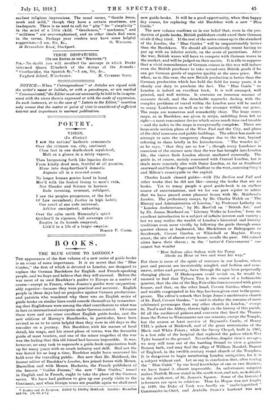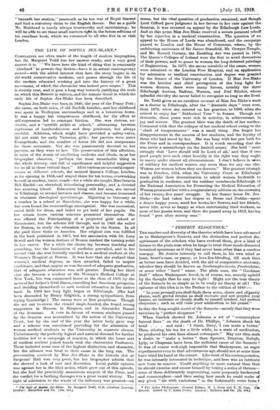BOOKS
•
THE BLUE GUIDE TO LONDON.*
Tax appearance of the first volume of a new series of guide-books is an event of some importance. It is no secret that the Blue Guides," the first of which is devoted to London, are designed to replace the German Baedekers for English- and French-speaking people, and we hope and believe that they will succeed. Before the war most of us used Baedeker's guides to Europe as a matter of course—except in France, where Joanne's guides were unquestion- ably superior—because they were practical and accurate. English people in those days had no prejudice against German productions, and patriots who wondered why there was no English series of guide-books on similar lines could console themselves by remember- ing that Englishmen were among the chief contributors to what was in fact an international enterprise under German control. Of course there were and are some excellent English guide-hooks, and the new editions of Murray's Handbooks, in particular, have been revised so as to be more helpful than they were in old days to the traveller on a journey. But Baedeker, with his masses of local detail, his maps, and his street-plans of towns, was the favourite guide of most tourists, and one of the minor tragedies of the war was the feeling that this old friend had become impossible. It was, however, no easy task to supersede a guide-book organization built up for many years with so much industry and skill. Had not the war lasted for so long a time, Baedeker might have recovered his hold over the travelling public. But now that Mr. Muirhead, the former editor of Baedeker's London, has joined forces with Messrs. Macmillan and with Messrs. Hachette, the French publishers of the famous " Guides Joanne," the new " Blue Guides," issued in English and in French, ought to take the place of the German series. We have had perforce to give up our yearly visits to the Continent, and when foreign tours are possible again we shall need • London and OS Environs. Edited by Findlay Muirbcad. London ; Macmillan and Co. 17e. lid. aell new guide-books. It will be a good opportunity, when that happy day comes, for replacing • the old Baedeker with a new " Blue Guide."
The new volume confirms us in our belief that, even in the pro- duction of guide-books, British publishers could excel their German rivals if they tried. If the rest of the series comes up to the standard of the London, the " Blue Guides " will be unquestionably better than the Baedekers. We should all instinctively resent having to
put up with an inferior article, on the score of patriotism. After the war, British wares will have to compete with German wares in the market, and will be judged on their merits. It is idle to suppose that a vivid remembrance of German crimes in this war will induce even the British purchaser to take second-rate British goods if ho can get German goods of superior quality at the same price. But when, as in this case, the new British production is better than the German production which has held the field for many years, it is clearly our duty to proclaim the fact. The " Blue Guide " to London is indeed an excellent book. It is well arranged, well printed, and well written. It contains an immense amount of accurate detail, and the detachable appendix dealing with the complex problems of travel within the London area will be useful to many Londoners as well as to the stranger within our gates. The maps are numerous and remarkably clear. The large street maps, as in Baedeker, are given in strips, unfolding from left to right—a most convenient device which saves much time and trouble —and the index to the maps is exceptionally complete. There are large-scale section plans of the West End and the City, and plans of the chief museums and public buildings. The editor has made no attempt to note the temporary changes due to the war, beyond referring to them briefly in his Introduction. " The wonder is," as he says, " that they are so few " ; though. every Londoner is conscious of the sterner note that the war has brought into London life, the visitor finds London almost unaltered externally. The guide is, of course, mainly concerned with Central London, but it deals more concisely also with Outer London, as far as Southend eastward and Stoke Poges and Chalfont to the west, annexing Gray's and Milton's countryside to the capital.
Charles Lamb classed guides—with The Decline and Fall and other works that he did not like—among the books that are no books. Yet to many people a good guide-book is an endless source of entertainment, and we for our part rejoice to admit that we have passed some pleasant hours with Mr. Muirhead's London. The preliminary essays, by Mr. Charles Welch on " The History and Administration of London," by Professor Lethaby on " London Architecture," by Mr. MacColl on " British Art.," and by Dr. James Muirhead on " Literary Walks in London," form an excellent introduction to a subject of infinite interest and variety ; but we may realize the wealth of London's historical and literary traditions even more vividly by following the guide through some quarter chosen at haphazard, like Blaekfriars or Bishopsgate or Southwark, Covent Garden or Whitehall or Mayfair. Every street, the site of almost every house, recalls the past. Old ruined cities have their chasm ; in the " batter'd Caravanserai " one cannot but wonder " How Sultan after Sultan with his Pomp Abode an Hour or two and went his way."
But there is more of the spirit of romance in our London, where past and present are inextricably mingled, and fashion and com- merce, riches and poverty, have through the ages been perpetually changing places. If Shakespeare could revisit us, he would be amused to find that Tyburn Tree is the centre of a fashionable quarter, that the site of the May Fair of his time is covered with great houses, and that, on the other hand, Covent Garden, where rank and wealth congregated in his day, has been given over to the green- grocer. The editor's remark that Inigo Jones's unobtrusive church of St. Paul, Covent Garden, " is said to shelter the remains of more celebrated personages than any other church in London," except St. Paul's and the Abbey, throws light on the history of this parish. Of all the mediaeval palaces and convents that lined the Thames from the Tower to Westminster not one remains, except the Temple, but the names at least survive of Ba3-nard's Castle, of Henry VIII.'s palace of Bridewell, and of the great monasteries of the Black and White Friars ; while the Savoy Chapel, built in 1505, is a last relic of the hospital that replaced the palace which \Vat Tyler burned to the ground. Nevertheless, despite time's ravages, we may still turn out of the bustling Strand to view a genuine Roman bath, and may find the effigy of William Marshal, Regent of England, in the twelfth-century round church of the Templars. It is dangerous to begin mentioning London antiquities, for it is a subject without end. Let us say in conclusion that, after testing the " Blue Guide " by our local knowledge of one or two districts, we have found it almost impeccable. An unfortunate misprint makes Norfolk House stand in the south-west, and not, as it should, in the south-east, of St. James's Square. Some of the historical references are open to criticism. Thus La Hogue was not fought in 1699, the Duke of York was hardly an " undistingwehed " Commander-in-Chief, and Arabella Stuart's husband was not " beneath her station," inasmuch as he too was of Royal descent and had a statutory claim to the English throne. But as a guide Mr. Muirhead is nearly always trustworthy and entertaining; he will be able to set these small matters right in the future editions of his excellent book, which we commend to all who live in or visit London.



























 Previous page
Previous page